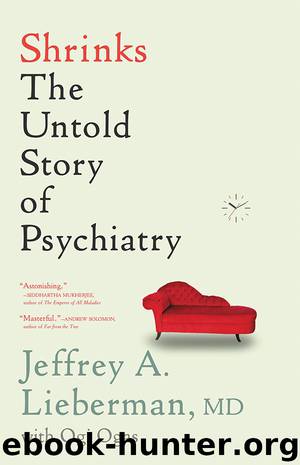Shrinks by Jeffrey A. Lieberman

Author:Jeffrey A. Lieberman
Language: eng
Format: epub
Tags: Psychology / Mental Health, Psychology / History, Medical / Neuroscience
Publisher: Little, Brown and Company
Published: 2015-03-09T16:00:00+00:00
Chapter 6
Mother’s Little Helper: Medicine at Last
Mother needs something today to calm her down
And though she’s not really ill
There’s a little yellow pill
She goes running for the shelter of a mother’s little helper
—MICK JAGGER AND KEITH RICHARDS
It’s better to be lucky than smart.
—HENRY SPENCER
Chloral Simmerings in My Spine
These days, it’s difficult to imagine the practice of psychiatry without medication. You can hardly watch TV without seeing an ad for some mood-enhancing pill, usually featuring merry families frolicking on sandy beaches or joyous couples hiking through sun-dappled forests. Young people are far more likely to associate my profession with Prozac, Adderall, and Xanax than reclining on a couch week after week, divulging one’s dreams and sexual fantasies. Schools, colleges, and nursing homes in every state openly endorse the liberal use of psychoactive drugs to mollify their more disruptive charges. What is less well known is that psychiatry’s dramatic transformation from a profession of shrinks to a profession of pill-pushers came about through sheer serendipity.
When I was born, not a single therapeutically effective medication existed for any mental disorder. There were no antidepressants, no antipsychotics, no anti-anxiety drugs—at least, no sort of psychiatric drug that quelled your symptoms and enabled you to function effectively. The few existing treatments for the major categories of mental illness (mood disorders, schizophrenia, and anxiety disorders) were all invasive, risky, and burdened with appalling side effects, and these desperate measures were mostly used to control disruptive inmates in mental institutions. Similarly, the first psychiatric drugs were not intended to be curative or even therapeutic—they were blunt instruments for pacification. Their daunting side effects were only deemed acceptable because the alternatives—fever cures, coma therapy, induced convulsions—were even worse.
In the late nineteenth century, asylums used injections of morphine and other opiate-derived drugs to subdue recalcitrant inmates. While the patients may have ranked this among the most agreeable psychiatric treatments of the Victorian Era, the practice was discontinued once it became clear that opioids turned patients into hardcore addicts. The first behavior-altering drug commonly prescribed outside of asylums (psychotropic drug, in the argot of medicine) was chloral, a sleep-inducing non-opiate prescribed to relieve insomnia in anxious and depressed patients. Like morphine, chloral was not intended to treat a patient’s most salient symptoms—namely, the fearfulness in anxiety disorders or the feelings of sadness in depression—it was intended to knock the patient out cold. Chloral was preferable to morphine because it was reliable in strength from dose to dose and could be given orally, but patients disliked its awful taste and the distinctive odor it imparted to their breath, known as “alky-breath.”
Even though chloral was less addictive than morphine, it was still habit-forming. Women suffering from “nervous conditions” often self-administered the drug at home in order to avoid the embarrassment of institutionalization and frequently ended up as chloral addicts. The celebrated author Virginia Woolf, who suffered from manic-depressive illness and was repeatedly institutionalized, frequently swallowed chloral in the 1920s. From her boudoir, she wrote to her lover Vita Sackville-West about its effects:
Download
This site does not store any files on its server. We only index and link to content provided by other sites. Please contact the content providers to delete copyright contents if any and email us, we'll remove relevant links or contents immediately.
When Breath Becomes Air by Paul Kalanithi(7256)
Why We Sleep: Unlocking the Power of Sleep and Dreams by Matthew Walker(5637)
Paper Towns by Green John(4165)
The Immortal Life of Henrietta Lacks by Rebecca Skloot(3821)
The Sports Rules Book by Human Kinetics(3582)
Dynamic Alignment Through Imagery by Eric Franklin(3483)
ACSM's Complete Guide to Fitness & Health by ACSM(3462)
Kaplan MCAT Organic Chemistry Review: Created for MCAT 2015 (Kaplan Test Prep) by Kaplan(3419)
Introduction to Kinesiology by Shirl J. Hoffman(3297)
Livewired by David Eagleman(3117)
The River of Consciousness by Oliver Sacks(2989)
Alchemy and Alchemists by C. J. S. Thompson(2909)
The Death of the Heart by Elizabeth Bowen(2897)
Descartes' Error by Antonio Damasio(2728)
Bad Pharma by Ben Goldacre(2724)
The Gene: An Intimate History by Siddhartha Mukherjee(2489)
Kaplan MCAT Behavioral Sciences Review: Created for MCAT 2015 (Kaplan Test Prep) by Kaplan(2487)
The Fate of Rome: Climate, Disease, and the End of an Empire (The Princeton History of the Ancient World) by Kyle Harper(2431)
The Emperor of All Maladies: A Biography of Cancer by Siddhartha Mukherjee(2427)
